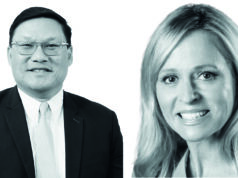
A mass shooting in Las Vegas. A bombing at the finish line of the Boston Marathon. A shooting at a Fourth of July parade. Healthcare workers may not be on the actual front line of disasters, but they’re definitely in the pipeline for the aftermath, when victims flood hospital emergency and operating rooms.
The question is, are those doctors, nurses, surgeons—and the institutions—ready?
Two trauma surgeons relayed their medical centers’ experiences with mass-casualty incidents during an “SVS Presents” webinar in August that focused on disaster preparedness. The webinar looked at mass casualties and how such incidents may affect the vascular surgery community. Moderator April Boyd, MD, PhD, chair of the SVS Education Committee, said SVS members told SVS leadership, in a needs assessment survey, that they want educational programs on leadership, particularly leadership in crisis.
Susan Briggs, MD, is an acute care and trauma surgeon and director of the International Trauma and Disaster Institute at Massachusetts General Hospital in Boston and discussed the 2013 Boston Marathon bombing. Deborah Kuhls, MD, is a trauma surgeon and medical director of University Medical Center’s Trauma Intensive Care Unit. She relayed the experiences at University Medical Center in Las Vegas following the 2017 shooting during the Route 91 Harvest music festival on the Las Vegas Strip.
Three people were killed in the bombing and hundreds were injured, including nearly 20 who lost limbs. In the shooting and its aftermath, 60 people died and more than 850 were wounded.
“Disaster medical care is not the same as conventional medical care,” Briggs said. That’s in terms not only of the severity of the injuries but also how likely a patient is going to survive, as well as the available resources.
In the acute phase, providers are working on “minimally acceptable, not maximally acceptable, care due to the large number of victims,” she said, adding, “Both are difficult lessons.
“The key principle in a mass casualty event is that the critical patients with the greatest chance of survival and the least expenditure of time and resources are treated first.”
Vascular surgeons who partner with other physicians and surgeons frequently are invaluable members of a disaster preparedness team, both doctors said. Vascular trainees would be invaluable as well.
“They can work with other surgeons of any specialty,” said Kuhls. “They have special skills.”
Briggs said, “Vascular surgeons are surgeons first. They can help with almost any operation. More and more we’re getting away from titles and functional capabilities and helping each other. We utilized vascular surgeons in almost every case with trauma surgeons.”
In the 2017 Las Vegas shooting, the shooter fired 1,100 rounds of military-grade ammunition in 13 minutes, toward more than 22,000 people at a multi-day concert on the Las Vegas strip. “We went from zero to 40 patients that were very critical within five minutes. Some had already died,” said Kuhls.
Because Las Vegas is a tourist destination used to hosting huge events, disaster training in different scenarios, particularly among the trauma centers, occurs at least quarterly, she said.
The shooting taught hospital leaders that “hospitals themselves need to be prepared, and not just individual healthcare workers,” said Kuhls. The Disaster Management Emergency Preparedness Course focuses on the institution as a whole, including how entire hospitals should go about doing drills and being prepared.
Both Briggs and Kuhls relayed other lessons learned during the respective events, which are available on the video recording.
The webinar was a collaborative effort of the SVS Education and Leadership Development committees, plus the Young Surgeons and Women’s sections. It can be viewed at vascular.org/MassCasualtiesWebinar. SVS members may watch at no charge; non-members will pay $35.











